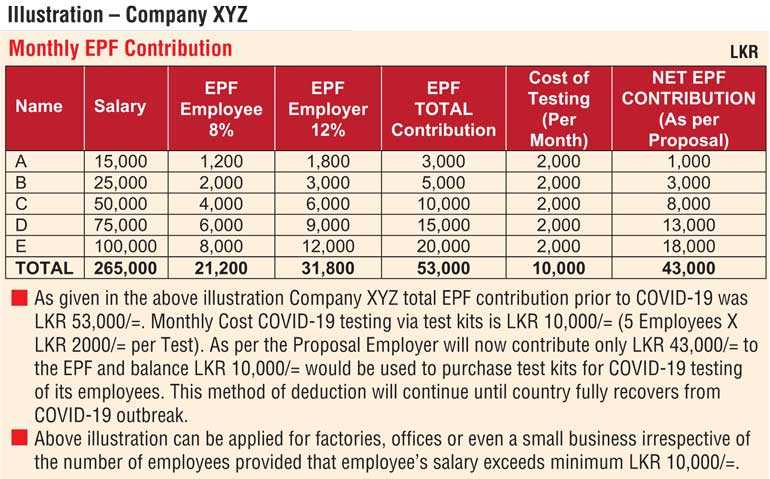Sunday Nov 23, 2025
Sunday Nov 23, 2025
Tuesday, 13 October 2020 00:54 - - {{hitsCtrl.values.hits}}

Post COVID-19 lockdown and post General Election 2020, most Sri Lankans never thought or hardly imagined a resurgence of the worst global pandemic in 21st century so far that has shaken the economies around the world.
However it is now a reality that we have to accept that our nation is fighting against a resurgence of the COVID-19 pandemic, with a fresh cluster that emerged around an apparel factory Brandix which had moved past 1,000 confirmed cases – the single largest yet in the island. This also shows that as a percentage the number of COVID-19 positive cases are higher among the people who have faced the PCR tests recently. 
In the first quarter of 2020 for the first time, due to the surge in the number of infections of COVID-19 in mid-March, the country was forced into a complete lockdown with all-day curfews-imposed country wide. The lockdown was in place for a period of nearly two months. Curfews were gradually eased with social distancing rules still in force.
During the initial wave of COVID-19, Sri Lanka faced major impacts, first being the virus itself and its health effects on those infected and the costs of resources deployed to control the virus in the form of medical resources and quarantine centres. The second impact stemmed from the mitigation strategy adopted by the Government. By implementing an elimination strategy using extensive indiscriminate curfews, the pandemic response had a substantial effect on livelihoods and the economy according to analysts. Whilst the costs endured in meeting the first impact are largely unavoidable, the costs of the second are dependent on the chosen strategy according to many analysts.
Today it is obviously impossible for a country that has 22 million people with a less than $ 90 billion GDP to afford another lockdown amidst a huge external debt portfolio and a bleak global economic outlook when there is an ongoing global pandemic that doesn’t have a vaccine as a cure.
Whilst the second wave in Sri Lanka has emerged from a larger corporate it is vital that a solution exist for companies, factories and small businesses to restart their business in COVID-19 free workplace through reliable testing of employees with government or a superannuation fund such as Employees Provident Fund (EPF) the most caring superannuation fund in the region backed relief proposal. Methodology proposed in this regard explained in below details in length could be considered equitable as all participants share the cost of testing.
Testing methods
COVID-19 testing can identify the SARS-COVID-2 virus and includes methods that detect the presence of the virus itself (RT-PCR, isothermal nucleic acid amplification, antigen) and those that detect antibodies produced in response to infection. Detection of antibodies (serology) can be used both for diagnosis and population surveillance. Antibody tests show how many people have had the disease, including those whose symptoms were minor or who were asymptomatic. Therefore currently available testing methods are as follows.
a) Antibody testing (self-testing using a test kits)
b) Antigen testing/PCR testing (laboratory testing)
It is assumed that antibody test kits are more convenient, reliable and less cumbersome method to test employees at workplace.
Annual cost of testing
There are only four companies approved by the FDA (Food and Drug Authority) of the USA for the manufacture of antibody test kits. It recommended to carry out one test per month.
Cost of antibody test kit – Rs. 2,000 (average $ 10)
Total cost per year per employee – Rs. 2,000 x 12 months = Rs. 24,000 (Average $ 120)
Cost Sharing
It is proposed that all employers purchase 12 months of antibody test kits based on the number of employees from a Government-approved supplier and carry out the necessary testing on a monthly basis. The cost incurred by the employer for the purchase to be set off against the monthly EPF contribution as illustrated.
As given in the illustration Company XYZ’s total EPF contribution prior to COVID-19 was Rs. 53,000. Monthly cost COVID-19 testing via test kits is Rs. 10,000 (five employees x Rs. 2,000 per test). As per the proposal the employer will now contribute only Rs. 43,000 to the EPF and balance Rs. 10,000 would be used to purchase test kits for COVID-19 testing of its employees. This method of deduction will continue until country fully recovers from COVID-19 outbreak.
Above illustration can be applied for factories, offices or even a small business irrespective of the number of employees provided that employee’s salary exceeds minimum Rs. 10,000.
Summary
This proposal offers a cost effective approach to all honourable corporate citizens of our country to re-open the economy quickly and avoid a resurgence of infections, which risks prompting further lockdowns and offering stimulus packages by adding to Government debt and bank loans which will be costly to both.
The cost of the test kits will be borne by the employee (or employer if they so decide) through EPF deduction, which would not burden the employer or the Government.
The HR department of a company should hold on to the test kits, have their employee visit HR each month, and tests to be documented and disclosed to the Ministry of Health (courtesy copies to other relevant ministries) every month. If the test results are not proactively documented, and disclosed by the first week of the following month, and there is even one incidence of a COVID-19 positive case involving an employee of that company, the Government reserves the right to shut the company down and enforce quarantine on all employees concerned.
In the first month of testing, if the antibody test kit shows positive results, then the employee must be sent to a hospital for COVID-19 testing, as he/she may have antibodies and floating virus at the same time. If the same happens in the following month, it provides no further risk.
(The writer is a veteran investment banker and a legal consultant in Sri Lanka, he could be reached via [email protected] or www.sumanadeera.com)